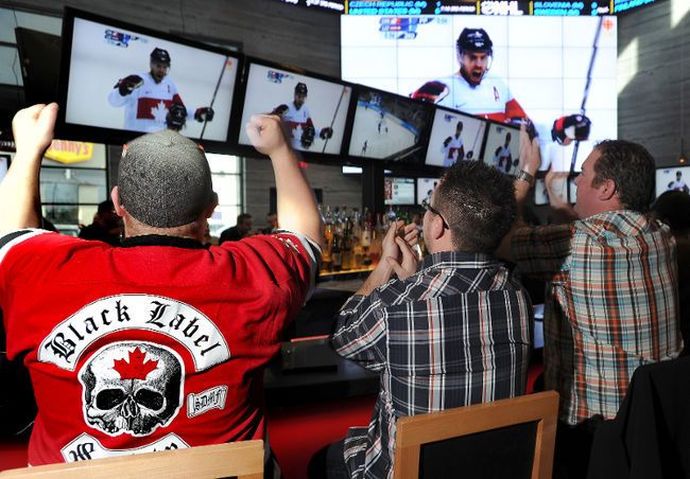|
One problem with trying to charge establishments that show televised sports more money for those broadcasts is that it leads to a weird philosophical debate: What exactly is a sports bar?
Also read, A quick look at beer consumption in Canada. This is among the many questions that are being thrown around in Canada’s restaurant industry with the recent news that Bell and Rogers, the owners of TSN and Sportsnet, will charge significantly increased rates to places with a liquor licence if they want to keep those sports channels in their programming lineup. Aside from the general sense of outrage that the sports-media giants, as Postmedia reported on Tuesday, are throwing this change at them with little warning — the new prices are set to go into effect on May 1 in most of Canada, later in Quebec — bar and restaurant owners are asking why every place that sells alcohol is being treated the same way. It’s a fair question. There are some establishments that make live sports viewing a fundamental part of their marketing. There are others that just want to have something on the TV from time to time, or where it’s usually a background distraction — something to keep the kids occupied when they are finished their chicken nuggets shaped like dinosaurs. But when the new fees for TSN and Sportsnet, which vary depending on television service provider and according to seating capacity, can run from an additional $75 a month to more than $650 monthly for larger venues, the question of how much of a business is really based on showing live sports becomes a significant one. For one owner of about a dozen chain restaurant locations, who spoke anonymously because he couldn’t comment on behalf of the parent company, the new sports-channel fees would cost his business an additional $50,000 annually, he says. His restaurants sell much more food than drink — about 10% of the sales are from alcohol — and so he says he’s giving serious thought to just forgoing television services completely. “I’d have unhappy customers come playoff time,” he says, “but certainly not every day.” He notes, too, that he’s a larger operator that has a choice about absorbing the higher costs: “But for the average family restaurant? It’s crazy what they are doing.” The “they” in this case refers to Bell and Rogers, which are changing their commercial rates to recapture revenue that has been lost as more people choose not to have a cable or satellite television subscription. The telecommunications conglomerates have told restaurant and bar owners that live-sports broadcasts have significant value to their businesses, and they feel that continuing to subscribe to TSN and Sportsnet at the new prices will be a good business decision. For some, that is almost certainly true. Even at an additional $250 monthly for a smaller bar, that would beat the alternative of having no out-of-market TSN or Sportsnet feeds. But there are many establishments where the calculus would not be so clear. Statistics Canada says there were just under 42,500 table-service restaurants in the country last year, including fine dining, casual dining (The Keg) and family style (Swiss Chalet). On average, those places have about 20% of their sales from alcohol. Many have televisions in a separate bar area, or they have several televisions in a distinct bar setup and a few out in the larger restaurant. But since Bell and Rogers are requiring the new fees for the sports channels to be based on seating capacity, a place with a large seating area but few televisions would still be charged at the upper end of the scale. There are other concerns. Many restaurants are licensed franchises, where the franchisee will have no choice but to pay the new costs since the corporate head office demands a consistent experience at all locations, and in some cases the largest of chains would have the most leverage to force a better deal out of Bell and Rogers since they spend a lot of money as advertisers on their large media networks. The small bar? Not much leverage. James Rilett of industry group Restaurants Canada says he’s asked to meet with Bell and Rogers executives and hopes they can work something out. “But to make this big a change without any consultation at all?” he says. “It does not bode well.” It’s worth pointing out here that the media companies are trying to charge more for something that they believe has been undervalued for certain customers. It’s not larceny, though the Competition Bureau might have thoughts on the timing of the changes made by would-be rivals. What the changes will mostly do, I think, is force proprietors to decide how much they care about live sports. It’s the kind of thing most patrons would figure out about any establishment after a visit: does this place care about having the game on, or is it essentially the wallpaper? The new fees will probably go some way to separating the latter from the former. SOURCE Scott Stinson, Postmedia Network
0 Comments
Leave a Reply. |
Advertisement
News & Updates
Stay informed with the latest news around foodservice, agriculture and other related food news. Advertisement Opportunities
|


 RSS Feed
RSS Feed


